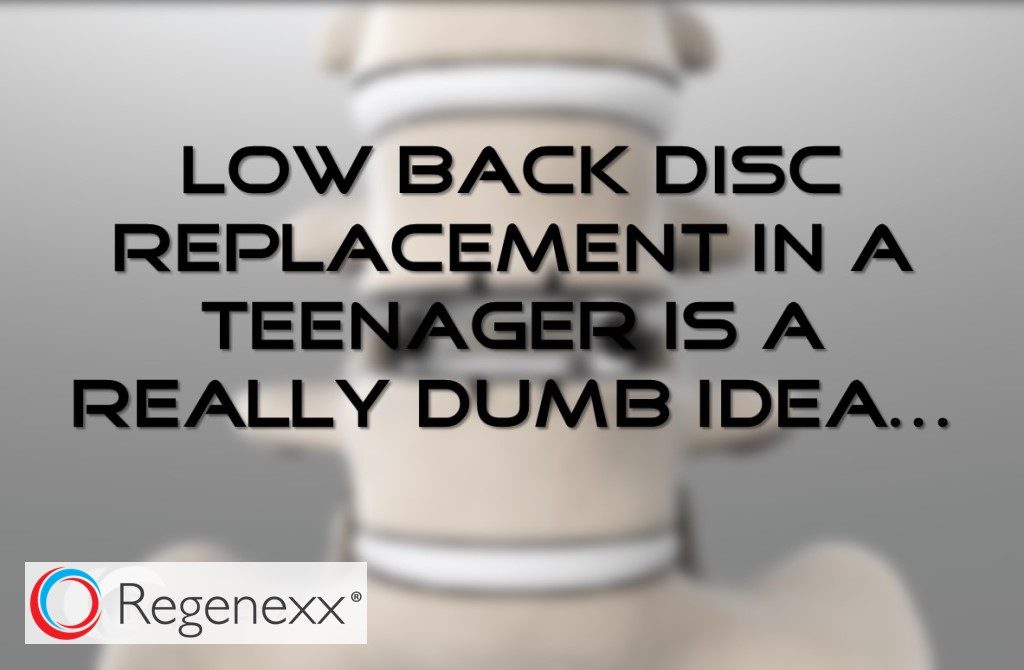Disc Replacement in a Teenager?
Is disc replacement in a teenager a good idea? Is fusion smart or dumb in this age group? This was the dilemma facing Analisa, a 20 year old young woman with a bad low back disc. In the end, she used advanced regenerative spine care to avoid both surgeries.
Analisa had a painful disc at L3-L4 that was degenerating, despite being in her late teens. The discs act as shock absorbers between the bones of the spine (vertebrae). They can become degenerative and can sometimes be painful in patients who have had trauma or just with the wear and tear of life. What’s less common is that one would become a problem in a teenager, but hers started to be an issue at the age of 12.
When I first evaluated her in February of this year, she was miserable. Her L3-L4 disc was no longer holding onto water on her MRI (dark disc) and a discogram had shown it to be causing pain. She was at a very low level of function and was spending every day in bed and couldn’t walk long enough distances to go shopping. One local surgeon had told her she needed a fusion of that disc, which is a surgery where the disc is removed and hardware and bone solidifies that level so it no longer moves. Another surgeon had told her she needed a disc replacement, a surgery where this disc is also removed and then an artificial metal/plastic disc is inserted. Thankfully for her, her insurance company had more sense than the surgeons, as they denied both procedures. Why was each of these surgeries a bad idea?
As I tell all of my patients, fusion is a dog with really big fleas. What I mean is that when you fuse a spinal segment that was built to move as part of a coordinated machine that moves (the spine), you get a broken machine. The part that’s fused invariably overloads the parts above and below, causing new problems. A disc replacement is a surgery designed to try and fix the problems of fusion, by installing a hockey puck sized device that allows some motion. The problem is that not only is this a big surgery, but in teenagers, the device will have to be replaced many times throughout their lives due to wear and tear. Each surgery will be a bigger and uglier affair and have ascending risks for the patient.
So what did we do? We ditched the idea of both surgeries and used her stellar 20 year old growth factors found inside her own platelets to treat the irritated nerves around the disc and tighten the loose and degenerative ligaments at that level. This was a series of precise image guided injections without surgery. The results? She now only spends 1-3 days a month resting in bed, her legs no longer throb, and she can walk distances, so shopping is a go!
The upshot? Fusing the low back of a teenager is a dumb idea. I’ve seen it happen a few times in my practice (not under my watch) when young patients, in more pain than ever, came into my practice having had their back fused by an overzealous surgeon. Replacing a disc in someone so young isn’t much smarter. In this case, the patient’s insurance company pushed her toward a better option. While I’m no fan of insurers, we are seeing them take a harder stance on fusion and given that I would estimate that only 10-20% of patients who get this nasty surgery actually have no other good choice, that’s not a bad thing!

If you have questions or comments about this blog post, please email us at [email protected]
NOTE: This blog post provides general information to help the reader better understand regenerative medicine, musculoskeletal health, and related subjects. All content provided in this blog, website, or any linked materials, including text, graphics, images, patient profiles, outcomes, and information, are not intended and should not be considered or used as a substitute for medical advice, diagnosis, or treatment. Please always consult with a professional and certified healthcare provider to discuss if a treatment is right for you.
